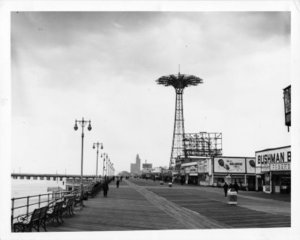NEW! "The Amusement Area: Past & Present," the first-ever Audio Walking Tour of Coney Island! Archival and contemporary photos, historical facts, anecdotes, and guided observation are used to explore Coney Island's past and present as well as its future possibilities.

Highlighting historic landmarks and sites endangered by redevelopment, the Coney Island History Project's free audio tours make the People's Playground accessible to visitors and armchair travelers 365 days a year. The tours provide valuable perspective on the historic and cultural importance of a world-famous neighborhood on the cusp of redevelopment.
Currently in beta test version, the History Project's free tours are downloadable as -- Audio + pictures/video on desktop/laptops -- Audio-only MP3 file for download to portable players (older iPods + non-iPod players) -- Audio + pictures/video for download to iPods and iPhones. There is also a version for playback on the iPhone via the AT&T mobile network.
The tour script is written and narrated by Charles Denson, CIHP Executive Director, Coney Island native and author of the award-winning book Coney Island Lost & Found.The first tour covers the Amusement Area: Past & Present. Highlights include Coney Island's four New York City landmarks: the 1920 Wonder Wheel and 1927 Cyclone Roller Coaster, which are operating rides; the 1939 Parachute Jump, refurbished by the city and celebrated as "Brooklyn's Eiffel Tower"; and the 1924 Childs Restaurant building on the Boardwalk, which is currently Lola Staar's Dreamland Roller Rink.
Sites endangered by change of ownership and redevelopment plans are another component of the tour. These sites include the Grasshorn Building (Coney's oldest, circa 1888); the 1925 Shore Theatre; Ruby's Bar and other vernacular architecture and signage along the Boardwalk, Bowery and Jones Walk. The tours contribute to preservation of an authentic sense of place by telling the stories of Coney's landmarks as well as its endangered sites. For example, the former Grasshorn Hardware Store (Coney's oldest building) and Henderson Vaudeville Theatre (where Harpo Marx made his stage debut in 1908) are considered ineligible for landmarking because they have been altered too significantly. The process of landmarking the Shore Theater is expected to begin soon. The History Project's Audio Walking Tour will help keep these endangered sites in the public eye while there is still hope to save them.
The Coney Island History Project's audio tour program is funded in part by the New York City Department of Cultural Affairs, NYC Councilman Domenic Recchia, Brooklyn Borough President Marty Markowitz, New York State Office of Parks, Recreation and Historic Preservation, State Assemblyman Alec Brook Krasny, and the Johanna Favrot Fund of the National Trust for Historic Preservation.

Add new comment